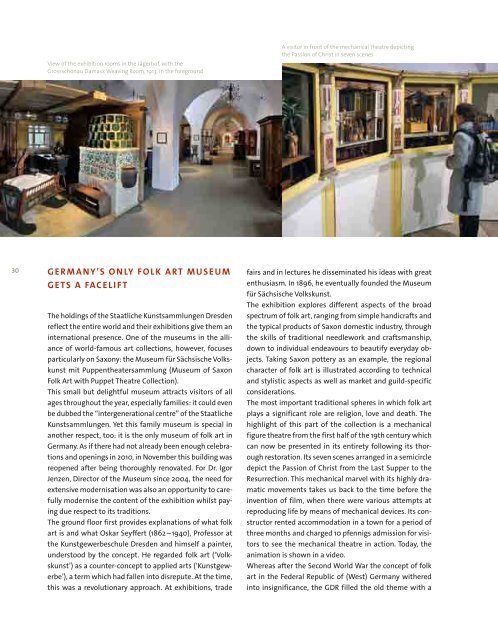Annual Report 2010 - Staatliche Kunstsammlungen Dresden
Annual Report 2010 - Staatliche Kunstsammlungen Dresden
Annual Report 2010 - Staatliche Kunstsammlungen Dresden
You also want an ePaper? Increase the reach of your titles
YUMPU automatically turns print PDFs into web optimized ePapers that Google loves.
30<br />
View of the exhibition rooms in the Jägerhof, with the<br />
Grossschönau Damask Weaving room, 1913, in the foreground<br />
GeRMAnY’S on lY FolK ARt MuSeuM<br />
GetS A FACelI Ft<br />
The holdings of the <strong>Staatliche</strong> <strong>Kunstsammlungen</strong> <strong>Dresden</strong><br />
reflect the entire world and their exhibitions give them an<br />
international presence. One of the museums in the alliance<br />
of worldfamous art collections, however, focuses<br />
particularly on Saxony: the Museum für Sächsische Volkskunst<br />
mit Puppentheatersammlung (Museum of Saxon<br />
Folk Art with Puppet Theatre Collection).<br />
This small but delightful museum attracts visitors of all<br />
ages throughout the year, especially families: it could even<br />
be dubbed the “intergenerational centre” of the <strong>Staatliche</strong><br />
<strong>Kunstsammlungen</strong>. Yet this family museum is special in<br />
another respect, too: it is the only museum of folk art in<br />
Germany. As if there had not already been enough celebrations<br />
and openings in <strong>2010</strong>, in November this building was<br />
reopened after being thoroughly renovated. For Dr. Igor<br />
Jenzen, Director of the Museum since 2004, the need for<br />
extensive modernisation was also an opportunity to carefully<br />
modernise the content of the exhibition whilst paying<br />
due respect to its traditions.<br />
The ground floor first provides explanations of what folk<br />
art is and what Oskar Seyffert (1862 – 1940), Professor at<br />
the Kunstgewerbeschule <strong>Dresden</strong> and himself a painter,<br />
understood by the concept. He regarded folk art (‘Volkskunst’)<br />
as a counterconcept to applied arts (‘Kunstgewerbe’),<br />
a term which had fallen into disrepute. At the time,<br />
this was a revolutionary approach. At exhibitions, trade<br />
a visitor in front of the mechanical theatre depicting<br />
the Passion of Christ in seven scenes<br />
fairs and in lectures he disseminated his ideas with great<br />
enthusiasm. In 1896, he eventually founded the Museum<br />
für Sächsische Volkskunst.<br />
The exhibition explores different aspects of the broad<br />
spectrum of folk art, ranging from simple handicrafts and<br />
the typical products of Saxon domestic industry, through<br />
the skills of traditional needlework and craftsmanship,<br />
down to individual endeavours to beautify everyday objects.<br />
Taking Saxon pottery as an example, the regional<br />
character of folk art is illustrated according to technical<br />
and stylistic aspects as well as market and guildspecific<br />
considerations.<br />
The most important traditional spheres in which folk art<br />
plays a significant role are religion, love and death. The<br />
highlight of this part of the collection is a mechanical<br />
figure theatre from the first half of the 19th century which<br />
can now be presented in its entirety following its thorough<br />
restoration. Its seven scenes arranged in a semicircle<br />
depict the Passion of Christ from the Last Supper to the<br />
Resurrection. This mechanical marvel with its highly dramatic<br />
movements takes us back to the time before the<br />
invention of film, when there were various attempts at<br />
reproducing life by means of mechanical devices. Its constructor<br />
rented accommodation in a town for a period of<br />
three months and charged 10 pfennigs admission for visitors<br />
to see the mechanical theatre in action. Today, the<br />
animation is shown in a video.<br />
Whereas after the Second World War the concept of folk<br />
art in the Federal Republic of (West) Germany withered<br />
into insignificance, the GDR filled the old theme with a

















